By
Jared Randall,
Web Analytics, GALE
CONTACT
hello@stagwellglobal.com
SIGN UP FOR OUR INSIGHTS BLASTS

A comprehensive digital analytics strategy is vital to running a successful business today. The problem is — it’s not easy to get right. It’s complicated. But it doesn’t need to be. Here are four common problems and solutions to deal with them:
1. Your website or app doesn’t convert as well as you think it should.
You have built what you think is a good website or app after months of planning and development. You have put some marketing dollars behind it to increase acquisition, and you are seeing more people visiting your website or app than ever before. The problem is, they’re not converting as well as you think they should. New users are visiting and not buying your product, service, or signing up for your membership program.
Using tools like Google Optimize or Optimizely can let your users ‘vote’ between two or more options by how they use your website and permanently implement the options they like best. For example, your organization likes a white ‘Buy Now’ button, but your users buy more when the button is blue. You can now make that data-driven informed decision, and everybody wins! Improvement is an iterative process, and we help identify where the friction is and how to optimize those areas with your collaboration.
2. You can’t tell the difference between web and digital analytics.
It is important to understand the difference between web and digital analytics and the importance of each source or platform in a digital strategy. A customer will interact with your brand through many different avenues; from email to search to social, each digital channel serves a purpose in interacting with your existing and prospective customers. Web and app also have their unique attributes and must be approached differently as well as holistically.
A customer could interact with a company’s website and its app over their lifecycle, so why treat them as being two different user profiles? By using Google Analytics/Firebase Analytics you can integrate and build robust cross-device and cross-platform measurement plans for web and app platforms, helping to ensure strategies are customer-led.
3. You genuinely don’t know your customers.
Many businesses still don’t know the complete journey a customer takes once they visit their website or app before converting or what prevents a prospective user from converting. In terms of your business’s analytics maturity, you still might be stuck in the descriptive analytics phase and only able to answer questions like ‘What happened?’ but not why it did. It is important to be adaptive with your approach and understand the changing consumer landscape, as customers visit through a growing number of channels and don’t always take the path we want them to take.
With one of GALE’s ecommerce clients, we performed analyses to identify which key pages a customer visits on websites before they convert and where they fall out of the funnel to better understand how their customers interact with their platform. By understanding the most important pages to a user, we were able to set up a paid media strategy around driving users to these pages.
4. You don’t know what story to tell with your data.
You have tracking on your website or app, data is coming into your Google or Adobe Analytics console, and you begin reporting on some metrics you think are your KPIs. But there is no story, just a series of disjointed summary metrics. This could be for a few reasons: your implementation is filled with errors or incorrect data, you don’t know what these metrics say about your website, or you don’t have enough information to create a clear picture.
All data has a story to tell, but you need the right storyteller to extract it, interpret it, and communicate it effectively. It’s important to take time to understand the business, map out the critical interactions a user makes on your website or app, and create a robust plan to get the data you need to share it in a way that tells a story about your users.
Digital Analytics should be, and will continue to be, a part of your organization’s core decision-making tools. We’re continuing to reach further stages of Analytics Maturity as your ‘Good’ digital analytics strategy has become ‘Not Good Enough’ in a few short years. It’s time to be proactive and take control of your future.
Related
Articles
In the News, Marketing Frontiers, Press Releases, Stagwell Marketing Cloud
Apr 02, 2025
The European Commission Expands its Partnership with UNICEPTA by PRophet to Include Media Analysis

Artificial Intelligence, In the News, Marketing Frontiers, Press Releases
Apr 02, 2025
Stagwell (STGW) Appoints John Kahan as Inaugural Chief AI Officer
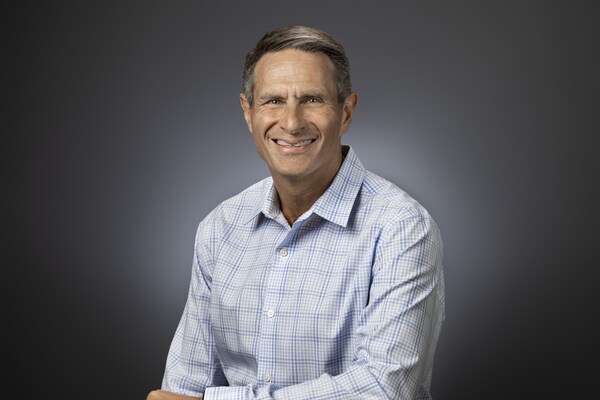
In the News, Investments & Financials, Press Releases
Apr 02, 2025
Stagwell (STGW) Will Host 2025 Virtual Investor Day and Announce $5 Billion Revenue Target by End of FY29

Newsletter
Sign Up
By
Barbara Laidlaw
Partner, Global Risk, Reputation + Public Affairs
Allison+Partners
CONTACT
hello@stagwellglobal.com
SIGN UP FOR OUR INSIGHTS BLASTS
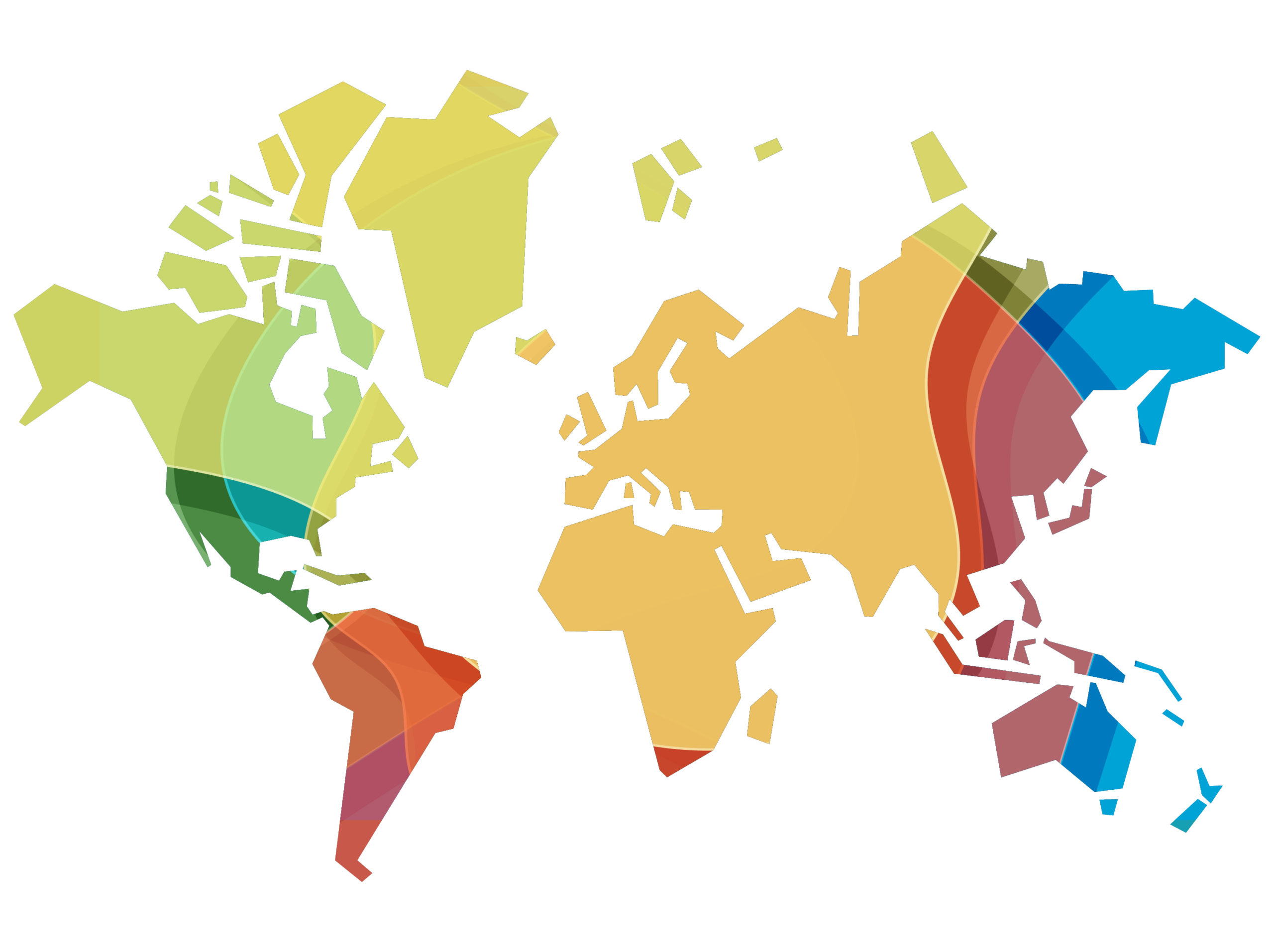
When an organization begins to expand globally, it often faces a new set of challenges that could mean adjusting current strategies that have yielded success on the domestic front. Economic, regulatory and operational factors are just some of the many considerations nascent global businesses must address to succeed on the international stage.
A less tangible but imperative concern is the organization’s reputation and how it will scale along with other elements of the business. Reputation takes years to build and only minutes to tarnish, making it one of the most precarious factors at play during expansion. Therefore, before pursuing an ambitious global footprint, businesses should consider how reputation management coexists with the following:
- Cultural & regional differences: Global expansion will require the ability to adjust some aspects of how a business operates to meet the standard of wherever the expansion takes place. Consider how different factors, such as language barriers, lifestyle, cultural history, education and politics, impact business objectives from employees’ and customers’ perspectives. By developing a strong understanding of these components and how they may factor into the business’s reputation, an organization will be positioned well to avoid pitfalls and preempt potential damage from related issues.
- Regulatory & political issues: Establishing an intimate understanding of how relevant political issues may affect the business is critical to avoid becoming trapped in them. Tapping into the expertise of third-party consultants and internal personnel within the region are just two ways a company can ensure it operates with the correct understanding of the political landscape. Strict regulatory compliance is another area in which businesses should invest resources to insulate themselves from running afoul of regulations or laws they may not have considered otherwise.
- Social impact & ESG: As organizations expand globally, they will inevitably increase their global footprint and their environmental and societal one. Depending on the nature of the business, there could be additional social considerations to account for, such as human rights or political turmoil. Today, enterprises prioritize their societal impact more than ever. To continue to thrive, global organizations must navigate the complexities that come with the recent rise in investor and consumer activism.
- Core values: As is true with any period of growth within an organization, maintaining core values is one of the most prominent challenges a business must contend with. This is only magnified when the company begins to expand globally. Upholding core values is essential to brand reputation and should be a priority item when considering further expansion. Emphasizing the importance of quality onboarding procedures, internal initiatives and other team-focused programs are ways a business can maintain its values as it grows.
- Communications infrastructure: Ultimately, scaling communications capacity and capabilities to match company growth will provide a business with the fundamental infrastructure it needs to preempt potentially damaging issues and effectively react to them when they occur. Through regular assessments of an organization’s communications capabilities, the business can proactively address weak spots and build on areas of strength, resulting in a more robust global communications program that underpins every core function of the business itself.
Navigating the reputational complexities of a global business is a challenge. While organizations should always remain prepared to tackle known sources of risk to their reputation, there will always be unpredictable events or incidents that present additional risks. Environmental disasters, wars, political turmoil, supply chain challenges and regulatory issues are just some of the many hurdles businesses need to contend with and overcome regularly.
Ultimately, the most effective way to mitigate the potential fallout from known and unknown risks is to continually ensure the organization is operationally resilient and maintains a robust communications infrastructure that it can leverage before, during and after an adverse event.
Barbara Laidlaw brings 25 years of experience developing and running programs that help companies prepare, protect and defend their brand reputations through global and national events, recalls, litigation, data breaches, regulatory issues and labor disputes.
Related
Articles
In the News, Marketing Frontiers, Press Releases, Stagwell Marketing Cloud
Apr 02, 2025
The European Commission Expands its Partnership with UNICEPTA by PRophet to Include Media Analysis

Artificial Intelligence, In the News, Marketing Frontiers, Press Releases
Apr 02, 2025
Stagwell (STGW) Appoints John Kahan as Inaugural Chief AI Officer

In the News, Investments & Financials, Press Releases
Apr 02, 2025
Stagwell (STGW) Will Host 2025 Virtual Investor Day and Announce $5 Billion Revenue Target by End of FY29

Newsletter
Sign Up
Originally released on
NEW YORK, May 24, 2022 /PRNewswire/ — Grocery stores are riding reputational highs two years after the start of COVID-19 – with regional chains in particular being recognized for weathering the supply-chain storm. At the same time, the pandemic-era halo many industries enjoyed are beginning to normalize.
Those are among the insights of the Axios-Harris Poll 100, an annual ranking of the reputations of the most visible U.S. companies, which was released today.
Trader Joe’s, HEB Grocery, Patagonia, Hershey and Wegmans have the top-five best reputations in America on the 2022 Axios-Harris Poll 100 list.
Social media platforms and companies with missteps on social issues are the ones with the poorest reputations or that suffered the steepest declines. This year, The Trump Organization, Wish.com, Twitter, Facebook and Fox Corporation are at the bottom of the 23rd annual list, with poor reputations.
“As Americans move on from COVID, they are looking at corporate reputation through a more practical lens,” said John Gerzema, CEO of The Harris Poll. “Companies delivering on time and keeping their promises despite supply-chain issues are being held in high regard. Businesses that also do their part to create a better world – whether through sustainability or taking a stand on authentic social issues – also are being rewarded.”
The Axios-Harris Poll 100 has ranked reputation since 1999. The survey’s Reputation Quotient (RQ) ranking is based on companies that are most visible to the general population and on their performance in seven key areas:
- Trust – “Is this a company I trust?”
- Vision – “Does this company have a clear vision for the future?”
- Growth – “Is this a growing company?”
- Products and Services – “Does this company develop innovative products and services that I want and value?”
- Culture – “Is this a good company to work for?”
- Ethics – “Does this company maintain high ethical standards?”
- Citizenship – “Does this company share my values and support good causes?”
“It’s back to basics with companies that offer quality products and are guided by steadfast values riding to the top,” said Stagwell Chairman and CEO Mark Penn. “Those that became enmeshed in political quagmires tended to be set back.”
This year, grocery dominates the top 100 list. Three grocers (Trader Joe’s, HEB Grocery and Wegmans) are in the top five. Two other grocery chains (Publix and Kroger) are among the top 25.
“The poll reinforces what we have seen on the ground with our local news product Axios Local,” said Jim VandeHei, co-founder and CEO of Axios. “To reestablish trust with a skeptical population, you have to start closer to home, making a real impact within local communities. Consumers reward brands that deliver a trusted product on time and as promised.”
Among the insights from this year’s study:
- Most visible: Amazon and Walmart are once again the two most visible companies in America, followed by Apple, Facebook, Google, Target, Nike, Microsoft, McDonald’s and AT&T.
- New to the list: Newly added to the 100 most visible companies list for the first time ever are Trader Joe’s, Spotify, Big Lots, Shein and Subway.
- Top 10: The most visible and most reputable companies – Trader Joe’s, HEB Grocery, Patagonia, Hershey, Wegmans, Samsung, Toyota, Amazon and Honda – are separated by only small degrees. All but Patagonia and Honda improved their reputations from last year’s highs.
- Industry movement: As the world moves out of the crisis phase of the pandemic, industries that saw massive reputations boosted by the crisis have returned to pre-pandemic levels. Consumer products dropped 12 points from 2021, returning to 2019 levels (2022: 62% positive, 2021: 74%, 2019: 61%). Meanwhile, while the halo surrounding the pharmaceutical and health insurance industries is fading, both remain significantly above pre-pandemic levels (pharma 2022: 49% positive, 2021: 60%, 2019: 31%) and (health insurance 2022: 49% positive, 2021: 60%, 2019: 32%).
- Perils of speaking out, or not: The economic and reputational loss from polarization hit companies once immune to politics and controversy. Disney fell significantly from last year – with the impact of being caught in a fight between politics and company values. Patagonia – which was number one on the list last year – continues its reputational high with great products combined with a strong societal view.
- Biggest improvements: Companies with at least a good reputation and the strong year-over-year improvement include AT&T (up 6.3%), Google (6.1%), Starbucks (6.0%), Yum! Brands (5.4%), General Motors (4.7%) and The Home Depot (4.5%)
- Biggest declines: Companies with the biggest reputational declines from last year include Stellantis (down 8.0%), Twitter (-4.9%), Pfizer (-4.7%), Disney (-4.3%), Trump Organization (-4.3%), Chick-fil-A (-3.7%), PepsiCo (-3.5%), eBay (-3.3%), ExxonMobil (-3.3%) and Electronic Arts (-3.2%).
“To excel at reputation, companies must deliver high marks on business performance, corporate character and trust,” said Ray Day, vice chair of Stagwell, which includes The Harris Poll. “While you can build a brand, you earn a reputation. Companies with strong reputations have a price advantage, a competitive advantage and a talent advantage. That’s why reputation needs to be a priority from the board room to the C-suite.”
The Axios Harris Poll 100 is based on a survey of 33,096 Americans in a nationally representative sample conducted March 11-April 3, 2022. The two-step process starts fresh each year by surveying the public’s top-of-mind awareness of companies that either excel or falter. These 100 “most visible companies” are then ranked by a second group of Americans across the seven key dimensions of reputation to arrive at the ranking. If a company is not on the list, it did not reach a critical level of visibility to be measured.
For information on all companies and their ranking on the 2022 Axios-Harris Poll 100, click here and here for an interactive graphic.
About The Harris Poll
The Harris Poll is one of the longest-running surveys in the U.S., tracking public opinion, motivations and social sentiment since 1963. It is now part of Harris Insights & Analytics, a global consulting and market research firm that delivers social intelligence for transformational times. We work with clients in three primary areas: building 21st century corporate reputation, crafting brand strategy and performance tracking, and earning organic media through public relations research. Our mission is to provide insights and advisory to help leaders make the best decisions possible. Learn more by visiting www.harrispoll.com and follow Harris Poll on Twitter and LinkedIn.
About Axios
Axios is a digital media company launched in 2017. Axios – which means “worthy” in Greek – helps you become smarter, faster with news and information across politics, tech, business, media, science and the world. Subscribe to our newsletters at axios.com/newsletters and download our mobile app at axios.com/app.
About Stagwell
Stagwell is the challenger network built to transform marketing. We deliver scaled creative performance for the world’s most ambitious brands, connecting culture-moving creativity with leading-edge technology to harmonize the art and science of marketing. Led by entrepreneurs, our 10,000+ specialists in 34+ countries are unified under a single purpose: to drive effectiveness and improve business results for their clients. Join us at www.stagwellglobal.com.
Related
Articles
In the News, Press Releases, Talent & Awards
Mar 12, 2025
GALE Wins Ad Age Business Transformation Agency of the Year and Adweek U.S. Media Agency of the Year

In the News, Press Releases, Talent & Awards
Mar 10, 2025
Four Stagwell (STGW) Agencies – 72andSunny, Anomaly, Code and Theory and GALE – Awarded 2025 Ad Age Agency A-List Recognition for Business and Creative Transformation

In the News, Press Releases
Mar 07, 2025
Left Field Labs Celebrates 17 Years of Building What’s Next Amid Expanding Global Client Roster
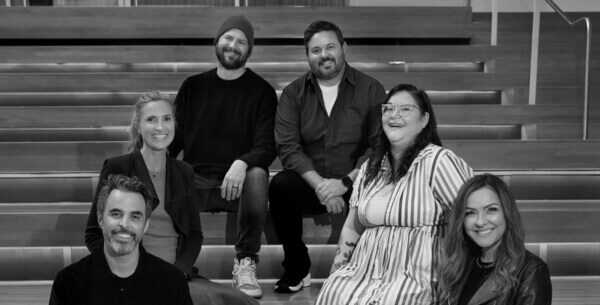
Newsletter
Sign Up
By
Stagwell Insights
CONTACT
hello@stagwellglobal.com
SIGN UP FOR OUR INSIGHTS BLASTS
Today’s businesses have more reputational capital than ever before. When reputation is managed, it has the potential to add business value and mitigate risks. Stagwell annually produces the Reputation Quotient, the industry’s leading barometer of American corporate reputation, in partnership with Axios and The Harris Poll to uncover insights which brands are gaining or losing reputational capital – and the expectations of a new generation of reputation-minded consumers.
The Axios Harris Poll 100 is a trusted ranking of the reputations of the companies most on the minds of Americans using a framework Harris has used since 1999. Download the 22nd Annual Reputation Quotient Study report to view the full rankings and gain additional insights about performance year over year.
Register to receive our 2022 research – set to release in late May – using this form. Reach out to hello@stagwellglobal.com if you have questions.
Methodology:
The Axios Harris Poll 100 is based on a survey of 42,935 Americans in a nationally representative sample. The two-step process starts fresh each year by surveying the public’s top-of-mind awareness of companies that either excel or falter in society. These 100 “most visible companies” are then rated by a second group of Americans across the seven key dimensions of reputation to determine the ranking. If a company is not on the list, it did not reach a critical level of visibility to be measured.
Related
Articles
In the News, Marketing Frontiers, Press Releases, Stagwell Marketing Cloud
Apr 02, 2025
The European Commission Expands its Partnership with UNICEPTA by PRophet to Include Media Analysis

Artificial Intelligence, In the News, Marketing Frontiers, Press Releases
Apr 02, 2025
Stagwell (STGW) Appoints John Kahan as Inaugural Chief AI Officer

In the News, Investments & Financials, Press Releases
Apr 02, 2025
Stagwell (STGW) Will Host 2025 Virtual Investor Day and Announce $5 Billion Revenue Target by End of FY29

Newsletter
Sign Up
By
Ray Day
Stagwell Vice-Chair
CONTACT
hello@stagwellglobal.com
SIGN UP FOR OUR INSIGHTS BLASTS

“It takes 20 years to build a reputation and five minutes to ruin it. If you think about that, you’ll do things differently.” – Warren Buffet
Today, corporate reputation means more than mastery of the marketplace. Reputation is a measure of what all stakeholders – including consumers, employees, shareholders, and more – think about a company.
Contrary to “brand” – which measures a company’s products & services, typically among specific consumer segments, a reputation is earned not created.
Reputation is comprised of your company’s performance + its behavior in the marketplace, reflected through its internal and external marketing communications. When reputation is curated, it has the potential to build business value and can help mitigate risks. Companies with excellent reputations are more likely to garner positive outcomes, such as advocacy, community expansion and purchase intent.
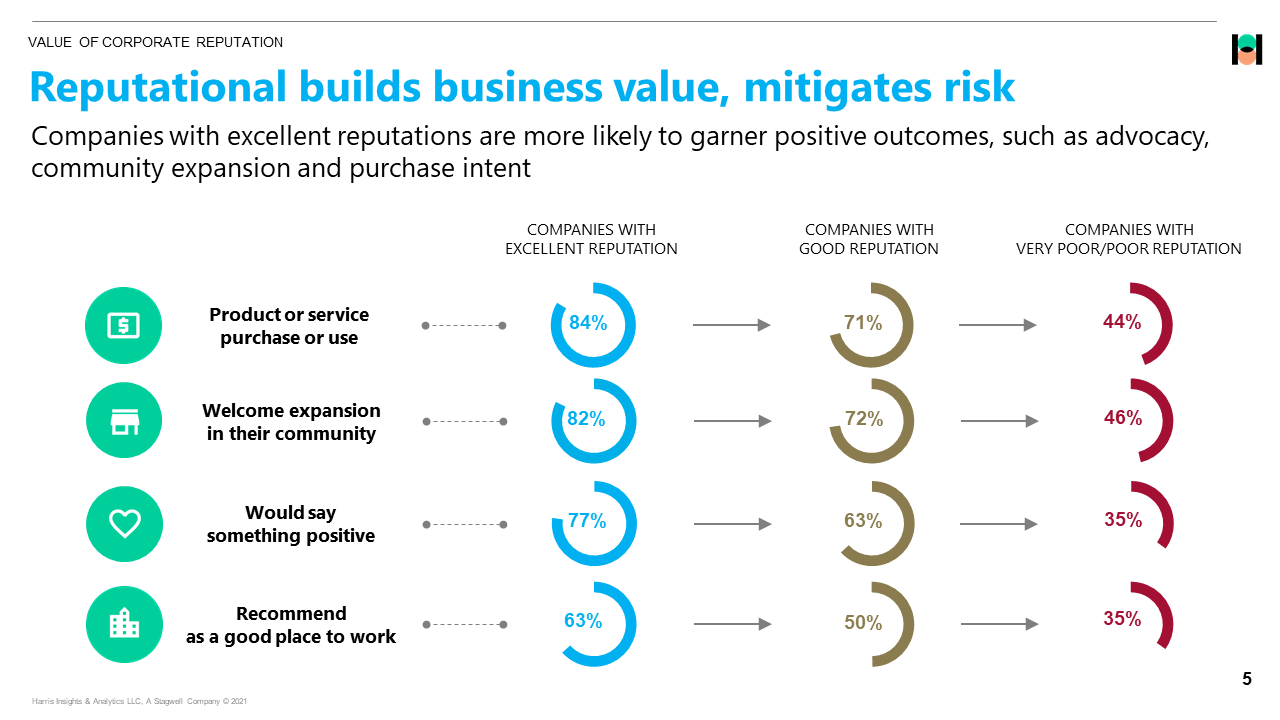
Today’s corporations and CEOs have greater permission from the public to address complex social issues – within bounds. Reputation today is evolving today to reflect more than just a product or service set, but a businesses’ commitment to serve society.
In recent years, geopolitical, economic, and social developments have created a society in transition and turmoil. Consumers have more expectations of corporations in this environment – not least because of declining trust and expectations in institutional actors such as governments and municipalities. As measured by Stagwell’s 2021 Reputation Quotient, brands across nearly every business sector experienced a reputational boost during the height of the pandemic as consumers looked to the private sector for solutions where public officials were failing to create them:
CEOs, and in a limited capacity other star of the C-Suite such as CMOs, are rapidly gaining reputational capital within the market and with consumers. They influence sales, perceived product/service quality, and signal the strength of an organization’s culture. As CEO reputation extends outward, when to exert influence in society becomes more calculated and more important. Americans say CEOs most affect reputation, ethics, and financial success for today’s organizations. CEOs also have a growing public awareness and influence on consumer sales; half of Americans report changing buying habits due to the actions of a CEO.
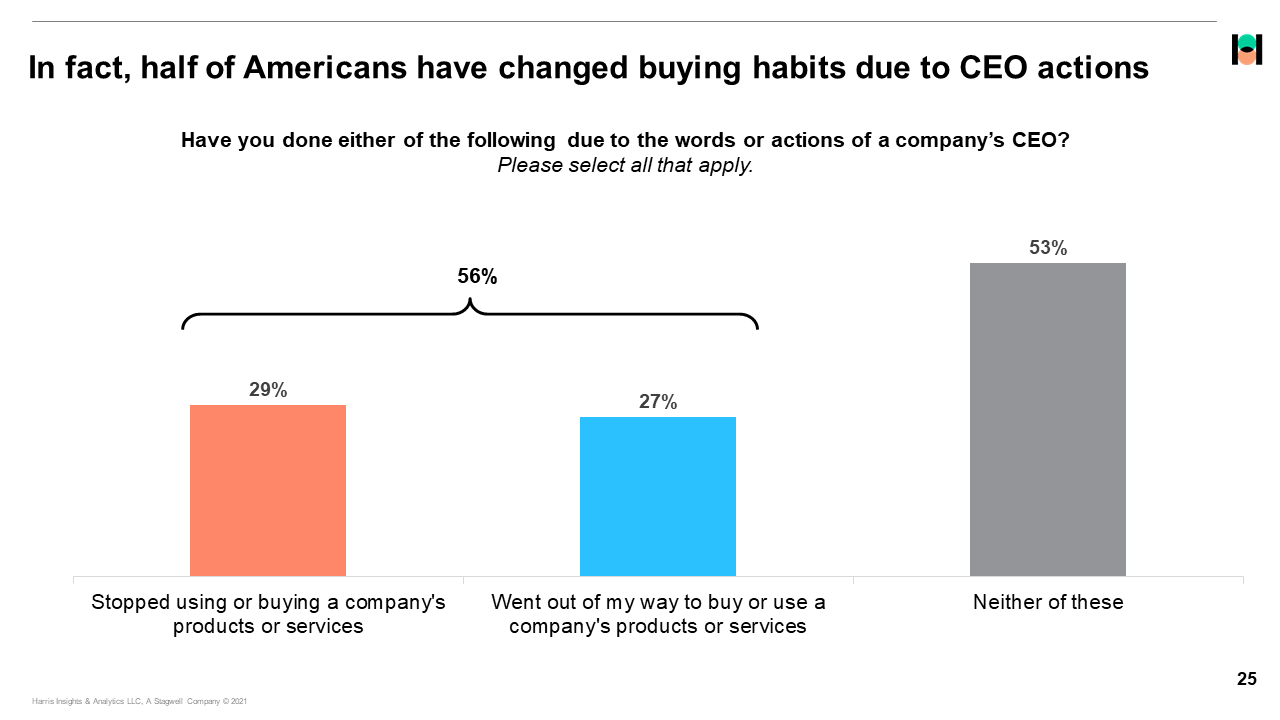
More traditional C-suite players like Jamie Dimon at Goldman Sachs leverage influence in quieter, more sustained ways – Dimon’s annual letter is a bellwether for the future of global financial markets, with wide-ranging through leadership implications for businesses within and beyond the financial services category.
With that reputational capital comes the burden of leadership: the public believes CEOs should stand on issues where they have credibility, not where they don’t have a voice or authority. Ultimately, core values should be the navigator of social issues. Alienation is a risk in a highly polarized society, but so too is the risk of stakeholders who perceive CEOs as indifferent or in conflict with the company’s principles. This is especially true among younger and Black Americans. While standing down is expedient, a generational and cultural divide is growing that will make decisions more difficult and polarizing.
Corporate and CEO reputation is changing quickly. Stagwell is a leader in global reputation tracking and management; learn more about the Reputation Quotient, an annual collaboration between Stagwell, Axios, and The Harris Poll tracking the most visible companies in America. Register to receive our 2022 research when it releases in May.
Related
Articles
In the News, Marketing Frontiers, Press Releases, Stagwell Marketing Cloud
Apr 02, 2025
The European Commission Expands its Partnership with UNICEPTA by PRophet to Include Media Analysis

Artificial Intelligence, In the News, Marketing Frontiers, Press Releases
Apr 02, 2025
Stagwell (STGW) Appoints John Kahan as Inaugural Chief AI Officer

In the News, Investments & Financials, Press Releases
Apr 02, 2025
Stagwell (STGW) Will Host 2025 Virtual Investor Day and Announce $5 Billion Revenue Target by End of FY29

Newsletter
Sign Up
By
Kaitlyn Schembri
Contributor, Koalifyed
CONTACT
hello@stagwellglobal.com
SIGN UP FOR OUR INSIGHTS BLASTS
With the advent of social commerce, influencers have never been more important. Global sales driven by social commerce will triple to $1.2 trillion by 2025. At the same time, user-generated content is on the rise, accounting for 39% of weekly media hours consumed by Americans. We’re living in the age of nano-influence, driven by the professionalization of the Creator Economy and brand investments in social commerce.
In the old days of influencer marketing, celebrity partnerships were strong drivers of top-of-funnel marketing. A-listers like Betty White gave brands wide-ranging exposure. No wonder brands lead with celebrities at the Super Bowl; on a stage with a hefty price tag, leveraging talent with a built-in fan base makes sense. Salesforce’s recent Big Game ad with Matthew McConaughey was a memorable callback to his 2014 hit “Interstellar.” It likely did little to drive conversion when it aired but drove conversation for days afterward.
With the rise of social commerce and performance measurement, creators boast an enviable position in today’s brand marketing playbook. In-app social marketplaces that let consumers shop the entire funnel on Instagram and TikTok mean the power of a single influencer post holds more weight than ever before. Consumers no longer need to see your website to make a sale – and it’s likely they don’t want to!
Nano-influencers are today’s driver of commerce. TikTok, more than any other platform, is driving this trend. Over the past two years, TikTok has democratized the digital world, allowing creators to reach a large audience on the app without a substantial following (and, in some cases, hardly any following at all). The algorithm prizes discovery over drudgery, priming niche content and creators with fewer than 10K followers to capture eyeballs (and results).

In this landscape, nano influencers are an authentic way for brands to connect with consumers. Frequently the tastemakers and thought leaders of their niche communities, they command the respect of small but mighty followings. Consumers are more likely to view them as friends than other-worldly celebrities, adding trust and engagement. Studies have shown that while 3% of consumers would consider buying a product in-store if promoted by a celebrity, that number jumps to 60% for a nano-influencer.
Dunkin’ recently tapped into various influencers with fewer than 50,000 followers to power its latest “coffee-first” campaign. Analysis showed nano-influencers generated higher engagement rates, with an average engagement rate of 5.2%. Dunkin’ succeeded in organically growing a support base for its coffee ambitions.
Nano influencers also can help brands drive a positive impact on diversity & inclusion. Being purposeful in curating your influencer marketing partnerships can ensure your brand does its part in platforming diverse perspectives. Consider how nano-influencers from yet-unengaged segments might supplement your core marketing activities for major product launches. Launching a new foldable exercise bike for the WFH generation? Consider partnering with TikTok influencers who produce content on career acceleration for P.O.C. talent. You never know what content may come of the effort!
As nano influencers proliferate marketing campaigns, it’s critical brands have agile, scalable solutions for influencer marketing management. Creators should be natural extensions of the marketing team. Investing in the right tech to reach, negotiate, and communicate with them is essential for success in this era of super-charged social commerce.
When leveraging the power of nano influencers, do not overlook the vetting process. Brand safety controls are key in the wild west of today’s platform-fragmented internet, as is closely managing influencer spending. Many marketers fall prey to the hidden costs of fake follower bots on their influencer efforts, which threaten to diminish a campaign’s chances of success and harm trusted influencer relationships. Bot detection is vital to ensuring brands are getting the complete picture. At Koalifyed, we leverage our platform’s built-in S.N.I.F.F. technology to help brands reach a higher R.O.I. for their influencer marketing investments.
We hear success stories every day from brands utilizing nano-influencers to hit their marketing KPIs. We predict the gap between the brands who invest in this strategy versus those who don’t will only widen in the coming years as platforms double-down on social commerce development and authentic brand marketing remains a priority for consumers.
Related
Articles
In the News, Marketing Frontiers, Press Releases, Stagwell Marketing Cloud
Apr 02, 2025
The European Commission Expands its Partnership with UNICEPTA by PRophet to Include Media Analysis

Artificial Intelligence, In the News, Marketing Frontiers, Press Releases
Apr 02, 2025
Stagwell (STGW) Appoints John Kahan as Inaugural Chief AI Officer

In the News, Investments & Financials, Press Releases
Apr 02, 2025
Stagwell (STGW) Will Host 2025 Virtual Investor Day and Announce $5 Billion Revenue Target by End of FY29

Newsletter
Sign Up
By
Amber Roussel (Senior Director, Communications) and Toni Smith (Director of Social Marketing), MMI Agency
CONTACT
hello@stagwellglobal.com
SIGN UP FOR OUR INSIGHTS BLASTS

Today’s path to purchase inhabits a space foreshadowed in movies like Back to the Future, The Fifth Element, and Minority Report. We’ve moved from brick-and-mortar stores to the metaverse and from cash to credit to crypto, and the social commerce those classics previewed is now a crucial part of our modern marketing lexicon. The question now is no longer if social can become a driver of business but which platforms are leading the pack – and how to maximize value across the ecosystem. TikTok or Instagram? Brand-created environments or Pinterest? For 36 years, we’ve been helping brands navigate new worlds to better connect with their audiences and drive their businesses. Here’s a guide to getting in – and staying on top – of the social commerce game.
Selling Starts with Strategy
Here’s a powerful stat: 98% of consumers plan to purchase through social or influencer shopping at least once in 2022, per Sprout Social. That’s up tremendously from the 68% of consumers who reported doing so in 2021. This trend follows investments from Instagram, Facebook, TikTok, Snapchat, and Pinterest into dedicated shopping tabs that allow brands to “set up shop” in-platform and highlight their product catalogs. Soon, we could see these in-app shopping areas enable complete end-to-end purchasing.
To prepare for this new way of shopping, we suggest that brands:
- Identify the audience(s) they want to reach on social media
- Set clear goals and timelines
- Develop a social selling plan that includes paid media, organic social, and influencer marketing
- Implement a strong channel and content marketing strategy
- Leverage in-app shopping tools or a third-party e-commerce platform to facilitate social sales
Our advice to brands is always to be clear in your goals at the outset and embrace a test-and-learn mentality. Social commerce can be as dynamic as social media conversation. You need to embrace it and be ready to learn, pivot, and optimize in real-time. Those who are open to ‘experimentation’ will realize efficiency and success.
MMI clients, including ALOHA and Plant Apothecary, utilize social commerce to create end-to-end shopping experiences for their customers by pairing Instagram Shops with link-out to their websites. ALOHA also employs in-app shoppable links and social media influencers. In a recent ALOHA influencer campaign featuring two mid- and seven micro-tier influencers, sponsored social content received over half a million impressions and generated an overall engagement rate of 3.75%. Four of the nine influencers posted content on Instagram that achieved an engagement rate above 11%, indicating high interest in the brand and its products.
Where Is the Heat? Industries and Categories Seeing Success
Consumer electronics, fashion, and home items are trending in social shopping, with beauty and personal care products not far behind. Influencer partnerships play a significant part in this trend. If the higher-than-average engagement rates on posts containing #ad are any indicator, all influencer content – whether sponsored or not – works.
For Kate Spade, a limited-edition heart-shaped purse became an overnight bestseller when an influencer gushed about it on TikTok. Her post led to a host of user-generated content (UGC) when others posted videos of themselves buying and wearing the purse. The positive response encouraged Kate Spade to offer a version of the bag year-round. MMI also recently integrated a live shopping experience paired with custom influencer content to drive Dell laptop sales on Amazon.com. Gen Z and millennial influencers engaged shoppers in real-time via the Amazon Live Creator Stream. Total sales from promo code redemptions exceeded six figures from a single event.
Smart Brands Leverage Paid Amplification to Bolster Results
Although success is possible with organic social strategies, it can be challenging to break through without a robust paid media component. We believe a full-funnel paid media strategy is crucial for amplifying the overall impact of social selling, and can often lift campaign performance by 2-4 times on average. For one MMI client, clicks increased by 80% when we began testing sponsored creative from an influencer handle versus the brand handle. In a world ruled by algorithms, media campaigns arm brands with the ability to target audiences that may not organically encounter its content or products. We’ve found that Facebook and Instagram are still winning for lower-funnel conversions, and TikTok and YouTube generally outperform in terms of top-of-funnel awareness efforts.
Future Forward
Social commerce spend will reach $1.2 trillion by 2025: undoubtedly, the social media shopping cart is here to stay. How we help clients cash in on this gold rush with innovative social selling strategies will never be a one-size-fits-all approach. Aligning top-notch creative assets with influencer marketing + earned media outreach is a formula for success in today’s marketplace – and a scalable toolkit for embarking on this new frontier of social commerce.
Our DMs are open if you’re looking for partners to help make sense of it all. See you in the meta mall.
Learn more about how MMI can help you dominate the digital shelf here.
MMI Agency is a modern brand lab where performance meets possibility. Our mission is to inspire action by combining our end-to-end approach to reaching consumers with our tenacity for data.
Related
Articles
In the News, Marketing Frontiers, Press Releases, Stagwell Marketing Cloud
Apr 02, 2025
The European Commission Expands its Partnership with UNICEPTA by PRophet to Include Media Analysis

Artificial Intelligence, In the News, Marketing Frontiers, Press Releases
Apr 02, 2025
Stagwell (STGW) Appoints John Kahan as Inaugural Chief AI Officer

In the News, Investments & Financials, Press Releases
Apr 02, 2025
Stagwell (STGW) Will Host 2025 Virtual Investor Day and Announce $5 Billion Revenue Target by End of FY29

Newsletter
Sign Up
By Barbara Evans, Managing Partner, Mediaplus
CONTACT
hello@stagwellglobal.com
SIGN UP FOR OUR INSIGHTS BLASTS
NFTs – short-term hype or a serious, lasting trend? One thing at least is certain: Hardly any other topic is currently shaking up the digital world as much as non-fungible tokens, or NFTs for short. Whether it’s the crypto scene, the games market, the art world or the music world – everyone wants to participate in the latest digital gold rush. The NFT market was worth around $44 billion U.S dollars in 2021 (Chainalysis Inc.), rivaling the global art and antiques market, which generated sales of around $50 billion U.S dollars in the same period. No wonder marketers are interested in the technology. Read on for a short explainer on the phenomenon.
WHAT ARE NFTS (NON FUNGIBLE TOKENS)?
Non-fungible means “not arbitrarily replaceable”, i.e., they are individual pieces that cannot be duplicated. The term typically refers to digital assets such as images, videos, animations, audio pieces or graphics. NFTs take on the function of a digital certificate of authenticity and ownership, making the associated digital file a unique and uniquely identifiable asset – which is also quite forgery-proof: each NFT is given an individual ID and stored on a blockchain as a record that can be viewed online.
Non-fungible tokens are traded in cryptocurrencies such as Ethereum. The value of such a digital certificate can sometimes rise to astronomical heights, depending on whether it is a sought-after collector’s item or not. For example:
- In the spring of 2021, for example, the first tweet ever sent by Twitter founder Jack Dorsey on March 21, 2006, was auctioned off as an NFT for $2.9 million.
- The first source code for the World Wide Web by Tim Berners-Lee changed hands as an NFT for $5.4 million.
- An NFT from the legendary CryptoPunk series, which helped to trigger the hype surrounding tokens, achieved the fabulous price of almost 24 million dollars.
- The most expensive NFT traded so far is the digital artwork “The Merge” by the artist Pak, which fetched $91.8 million in December 2021.
HOW ARE NFTS BEING USED IN MARKETING?
The uses vary across industry.
- AUCTIONS
- Just before Christmas, for example, Vodafone auctioned off the first SMS sent via the British mobile company’s network in 1992. The telco giant donated the proceeds – 132,000 euros – to a good cause. The PR effect was far greater: more than 3,500 articles on the campaign were published worldwide in online alone, generating around two billion contacts. Coca-Cola was probably also concerned with the positive PR effect: In the summer of 2021, the beverage manufacturer auctioned four multisensory NFT collectibles for International Friendship Day, which could be experienced and used in different ways. The bright red “Coca-Cola Bubble Jacket Wearable,” for example, can be “worn” on the Decentraland 3D virtual reality platform by the avatar of the user who unlocked it. The “Sound Visualizer,” on the other hand, is designed to give an acoustic experience of enjoying an ice-cold Coke, from the fizz of an opening Coke bottle to the refreshing taste. The NFT auction raised a total of more than $ 575.000, which Coca-Cola donated to Special Olympics International.
- TRANSFERING BRANDS INTO THE METAVERSE
- Adidas Originals recently launched its first NFT collection under the slogan “Into the Metaverse.” The tokens give owners exclusive access to special products and experiences designed by Adidas in cooperation with NFT pioneers Punks Comic, Gmoney and Bored Ape Yacht Club, who are well-known in the scene. The roughly 30,000 NFTs, worth a total of more than $22 million, sold out in a matter of hours – even though the “physical” goods – a hoodie, tracksuit, and orange beanie – won’t be released until later in 2022. The digital counterparts of these are to be worn by NFT owners ins in the blockchain game “The Sandbox,” where Adidas has purchased a plot of land for its NFT community.
- INVESTING IN NFT ASSETS
- Nike is also heavily involved in the NFT business. In 2019, Nike patented the “CryptoKicks” system. Here, the sporting goods manufacturer wants to link limited shoes with a digital asset and “breed” new shoes virtually, which are then produced in real life. Finally, at the end of 2021, the company announced the acquisition of the world’s leading NFT producer RTFKT, which specializes in the design of exclusive digital sports shoes and sneakers.
WHAT SHOULD BRANDS WATCH OUT FOR AS THEY EXPERIMENT WITH NFTS?
The business of non-fungible tokens is not without its pitfalls. With the explosion of interest in the technology, the risk of crypto crime is also increasing. Wash trading is also becoming increasingly common in the NFT market — meaning the owner of a digital asset artificially drives up the price of an NFT through continuous buying and selling.
Additionally, there are questions about the ecological impact of NFTs. Blockchain can consume an enormous amount of energy and leave a large CO2 footprint. Both the production of an NFT and its sale on the blockchain require the computing power of thousands of computers. Brands for whom sustainability is key to positioning could face reputational issues with the use of NFTs.
WHAT IS THE OPPORTUNITY FOR BRANDS NOW?
It has always been the task of strong brands to be pioneers in emerging technology to drive new dimensions of the consumer experience. For brands whose identities are predicated on being challengers, or strong bridges believe this will also be the case in the area of Web 3.0, that of NFTs. Especially for a brand like Nike, whose essence is to build strong bridges to the popular culture of the new generation again and again, or even to be a cultural core itself, NFTs offer chances and opportunities to build ties that are truly “non-fungible”.
WHERE DO I GO NEXT?
Explore Stagwell’s content series on NFTs to learn more about:
Related
Articles
In the News, Marketing Frontiers, Press Releases, Stagwell Marketing Cloud
Apr 02, 2025
The European Commission Expands its Partnership with UNICEPTA by PRophet to Include Media Analysis

Artificial Intelligence, In the News, Marketing Frontiers, Press Releases
Apr 02, 2025
Stagwell (STGW) Appoints John Kahan as Inaugural Chief AI Officer

In the News, Investments & Financials, Press Releases
Apr 02, 2025
Stagwell (STGW) Will Host 2025 Virtual Investor Day and Announce $5 Billion Revenue Target by End of FY29

Newsletter
Sign Up
CONTACT
SIGN UP FOR OUR INSIGHTS BLASTS

Related
Articles
In the News, Marketing Frontiers, Press Releases, Stagwell Marketing Cloud
Apr 02, 2025
The European Commission Expands its Partnership with UNICEPTA by PRophet to Include Media Analysis

Artificial Intelligence, In the News, Marketing Frontiers, Press Releases
Apr 02, 2025
Stagwell (STGW) Appoints John Kahan as Inaugural Chief AI Officer

In the News, Investments & Financials, Press Releases
Apr 02, 2025
Stagwell (STGW) Will Host 2025 Virtual Investor Day and Announce $5 Billion Revenue Target by End of FY29

Newsletter
Sign Up
Stagwell is the challenger network built to transform marketing, deliver excellence for the world’s most ambitious brands by connecting culture-moving creativity with leading-edge technology. That’s why Stagwell loves SXSW, which is all about the intersection of technology, innovation and culture – a great fit for a global company committed to transforming marketing, content, and experiences.
Here’s a roundup of Stagwell showed up at SXSW, what we learned, and what it means for marketers:
The 5 Things You Missed at SXSW
From NFTs and the evolving Web3 landscape to the transformative power of digital audio, Stagwell’s experts share the top five trends and brand takeaways from SXSW 2022.
Get Smart with Matt Maher
Stagwell contributor Matt Maher provided “Get Smart” videos throughout the week, making sure those watching from home didn’t miss a single thing, and that those on the ground could keep up with the hours of programming SXSW put forward this year.
Matt brought his experience as a marketing and technology expert to bear, sifting through the flash to determine which of the new trends and technology have staying power – and how marketers should be parcing them to make the most of every platform.
MATT’S KEY SXSW 2022 TAKEAWAYS:
- THIS WAS NFT’S YEAR AT SXSW but most brands haven’t fully connected the dots to turn NFTs into a sustainable, relevant, brand-building moment. Look to the Doodle x Shopify activation for the most successful implementation.
- CONTENT CREATION ISNT A NUMBERS GAME ANYMORE – from gaming to Instagram, it’s more important to have a dedicating following of 10k than an apathetic community of a million.
- THE METAVERSE CONVERSATION IS MORPHING from enthusiasm to skepticism as it runs against ongoing tech debates – data, privacy and the psychological impact on users over time. We havent’ written it off yet, but brands have some big decisions to make before jumping in.
Matt walks us thorugh all this in more in his Get Smart series from the festival, check them our below and on the Stagwell @ SXSW YouTube playlist.
Stagwell’s on the Ground Recap with Nick Fuller
Why brave the Austin heat (or cold, as it was this year) when you have digital transformation expert Nick Fuller, Managing Partner of Digital Transformation at Stagwell, on the ground to make sense of it all for you? He’s our sherpa for all things technology x marketing, and his takeaways from a weekend on the ground show a bias towards first-mover advantage when it comes to all things Web3. There is also a new interpretation of the age old question of authenticity – whether its in creator partnerships or buy-in on new tech platforms, there’s a huge upside for brands who are operating with a clear vision of their message and where they fit in the market.
Driving the Future of Marketing with Stagwell
Marketing moves fast – and we’re ahead of the curve. On Monday March 14, Stagwell held an invite-only event at Circuit of the Americas, the US’ first and only purpose-built F1 track, to give this industry’s saviest competitors a once-in-a-lifetime experience.
The day started with a panel featuring Bennett Richardson, President of Protocol, Gayle Troberman, CMO of iHeart Media and Sally Shin, Chief Strategy Officer at UnitedMasters, discussing the future of audio marketing. They touched on core themes unearthed by Stagwell’s March Marketing Frontier on the Future of Audio, including the power fo audio and a connective device and the untapped potential of audio as an avenue for first-party data collection.
The group then broke up to make some noise themselves, rotating through a half-day racing school taught by the legendary Skip Barber Racing School. In no time, our marketing pros became driving pros, learning the fundementals for open-wheel race car driving from Skip Barber instructors who among them boasted half a dozen top-place finishes in racing classes across the board. It was an unforgettable day, and a reminder of why pushing the limits and moving quick can transformt he way you see a problem – and see the world.
Originally released on
CONTACT
Lorem Ipsum
FEATURING
Related
Articles
Events, In the News, Press Releases
Apr 09, 2025
Stagwell (STGW) Unveils New SPORT BEACH 2025 Athletes and Brand Partners Including Erin Andrews, Sir Mo Farah, Chris Paul, Alex Rodriguez, George Russell, Charissa Thompson and More
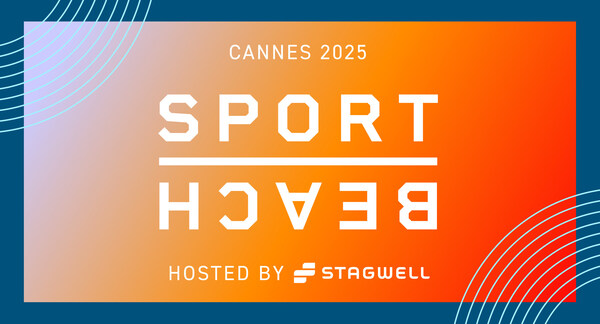
Events, In the News, Press Releases
Mar 18, 2025
Stagwell’s (STGW) Code and Theory Launches Inaugural Presence at Adobe Summit with the Announcement of its New Enterprise Experience Transformation Practice

Events, In the News, Press Releases
Mar 13, 2025
Stagwell (STGW) Reveals Latest Draft Picks for SPORT BEACH 2025, Including a Mix of New and Returning Athletes and Brand Partners














